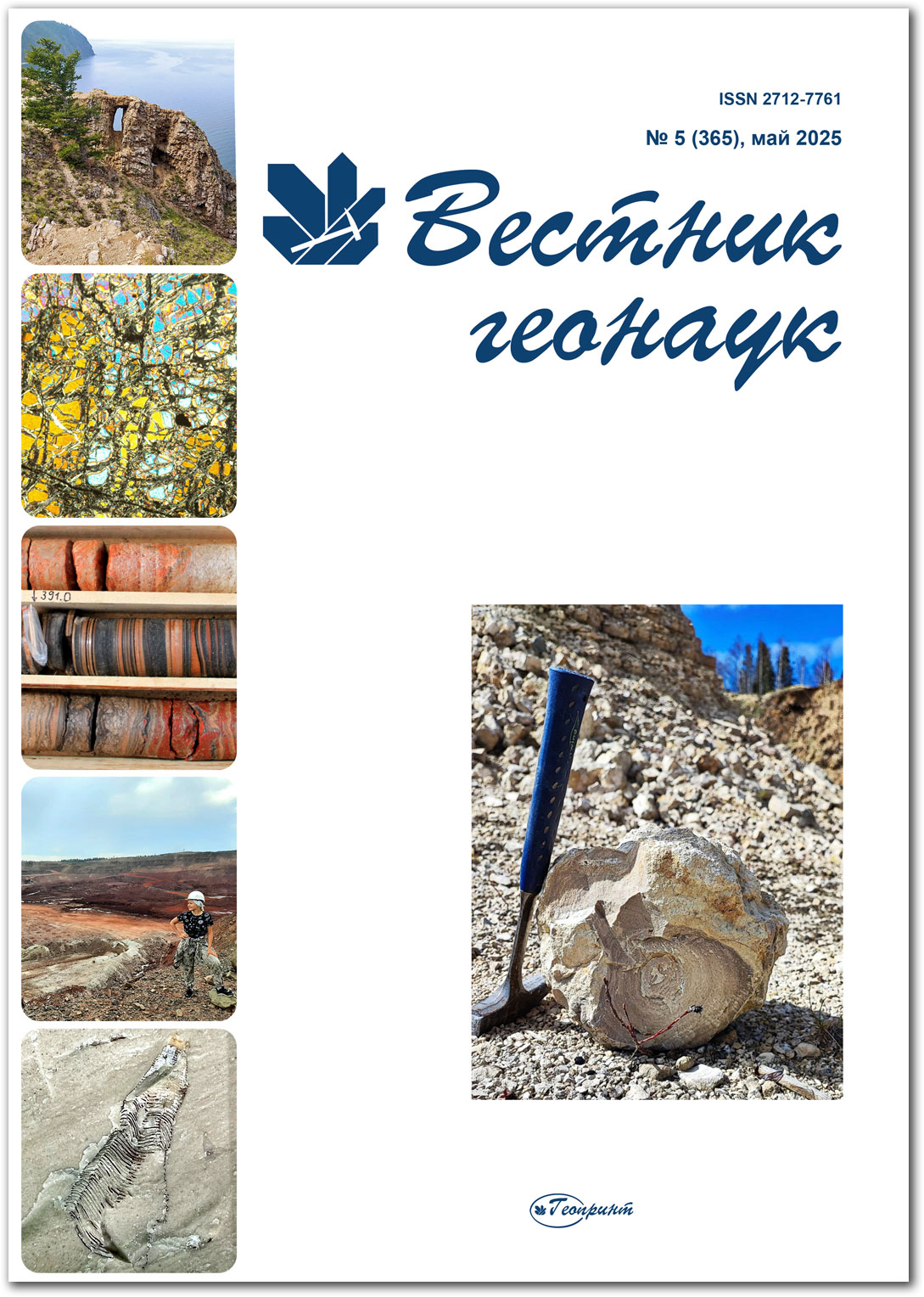|
On the cover: Trupetostroma uchtensis stromatoporoid, Upper Devonian, Frasnian stage, Sirachoy suite
(Ukhta area, Komi Republic). Photo by E. Antropova
|
|
| |
|
|
 Title page Title page
|
1
|
|
 Content Content
|
2
|
| |
|
|
|
|
Scientific articles
|
|
Ore potential prospects based on mineralogical data of the West Yangi-Umid site (Uzbekistan)
V. D. Tsoi, S. S. Saitov, A. V. Rasulova, S. E. Bulin
DOI: 10.19110/geov.2025.5.1
The relevance of this article lies in the assessment of the prospects for ore-bearing mineral composition of ores, its diversity in the West Yangi-Umid area. The subject of the research is ore minerals, stages of hypogene mineral formation. In the process of research, we used geological documentation of ore-bearing and mineralized zones, sampling, sample preparation for chemical and geochemical analysis, description of thin and polished sections, mineralogical analysis of gravity enrichment products, X-ray spectral microprobe studies, identification of vertical zoning of mineralization, a scheme of the stages of hypogene mineral formation based on mineragraphic data.
As a result of research, 26 ore minerals in the Western Yangi-Umid area were identified. A wide range of mineral formation — from the early oxide stage with magnetite-hematite PMA to quartz-calcite-barite-fluorite carbonate-fluoride stage indicates the prospects of the Western Yangi-Umid site. Among them, the pyrite-arsenopyrite with gold PMA of the early sulphide stage and gold-silver PMA of the same stage are productive for gold
Keywords: ore minerals, gold, hypogene mineral formation scheme, Western Yangi-Umid site, Ziaetdin ore field
 Download full text Download full text
|
3—9
|
Regional distribution patterns of resins and asphaltenes in Western Siberia oils
L. S. Borisova
DOI: 10.19110/geov.2025.5.2
The paper studies the spatial distribution patterns of resins and asphaltenes in the main regional oils reservoirs of the West Siberian megabasin. The studies on schematic maps for the main regional reservoirs (Lower and Middle Jurassic in general, Upper Jurassic (horizons П, Ю0, Ю1), Neocomian, Aptian-Albian-Cenomanian) show that, from the central regions in the northern, northeastern and southeastern directions, a decrease in the content of resins and asphaltenes in oils is observed. In the central part of Western Siberia, oils with a relatively high content of resins and asphaltenes, formed in deep-sea sediments with hydrogen sulfide contamination, are localized in Jurassic and Cretaceous deposits. In the northern regions of Western Siberia, where less reducing conditions existed in marine sediments and there was a significantly higher level of catagenesis, low-resin, virtually asphaltene-free, light oils are localized in Jurassic and Neocomian deposits. The constructed maps-schemes of distribution of resins and asphaltenes in oils can be used in forecasting the quality of oils, in assessing the prospects of oil and gas potential of the West Siberian megabasin.
Keywords: asphaltenes, resins, oil, Jurassic-Cretaceous deposits, Western Siberia
 Download full text Download full text
|
10—17
|
Degassing processes at the bottom of the Atlantic ocean
I. G. Dobretsova
DOI: 10.19110/geov.2025.5.3
The article presents an overview of degassing processes and their traces based on the results of long-term observations and analytical studies by the author while working on the research vessel “Professor Logachev”. On it, the Polar Marine Geological Exploration Expedition conducts research, including video observations in the axial zone of the Mid-Atlantic Ridge (MAR). Since 2012, work has been conducted within the Russian Exploration Area (REA), located on the Mid-Atlantic Ridge at coordinates from 20° to 13° N. During this time, several thousand linear kilometers of bottom video were filmed. The author of this review took part in eighteen such cruises, so she had the chance to directly observe various signs of degassing processes on the ocean floor. They are manifested in the form of small (rarely exceeding the first meters in diameter) channels in sediments and unusual patterns on sediments, as well as cracks, faults and channels in the underlying rocks. In addition, all hydrothermal structures, including chimneys of active and inactive smokers, are also the result of degassing processes. Within the young volcanic structures, both caldera and slot types, sintered sediments were raised, saturated with ash and fresh volcanic glass (the size of glass fragments rarely exceeds 1 cm). Such rocks are classified as tuffites, and its formation is also related to the degassing processes.
Keywords: Mid-Atlantic Ridge, degassing, smokers, channels, Benard cells
 Download full text Download full text
|
18—28
|
Сopper slags mineralogy of the Vyisky plant
Yu. V. Erokhin, V. S. Ponomarev, A. V. Zakharov, L. V. Leonova
DOI: 10.19110/geov.2025.5.4
The Ural region has been the metallurgical center of Russia for over 300 years and has accumulated a huge amount of slags. Studying their mineral composition is an urgent task, since many slags can be a threat to the environment and represent potential ore that can be further processed. In this paper we present the results of a study of the material composition of copper slags from the Vyisky plant (Nizhny Tagil, Sverdlovsk region). It has been established that the slags are composed of a hercynite-fayalite aggregate with the constant presence of magnetite, sulphides (troilite and «melt solid solutions» of the Cu-Fe-S system), as well as glass, native copper and westerveldite. The temperature of their formation is estimated in the range of 1186—1193 °C. The studied slags can be completely processed, namely, copper-sulfide, hercynite-magnetite and fayalite concentrates can be obtained from them, which can then be used in metallurgical processing. It is shown that sulfides in the slag dump decompose and there is a constant removal of chalcophile and siderophile elements, which increases the technogenic load on the population living here.
Keywords: fayalite, hercynite, sulphides, material composition, copper slags, Vyisky copper plant
 Download full text Download full text
|
29—34
|
|
|
| |
|
|
Chronicle, events, facts
|
|
| |
|
|
Fathers, who forged the Victory
 Download full text Download full text
|
35—36 |
|
|













